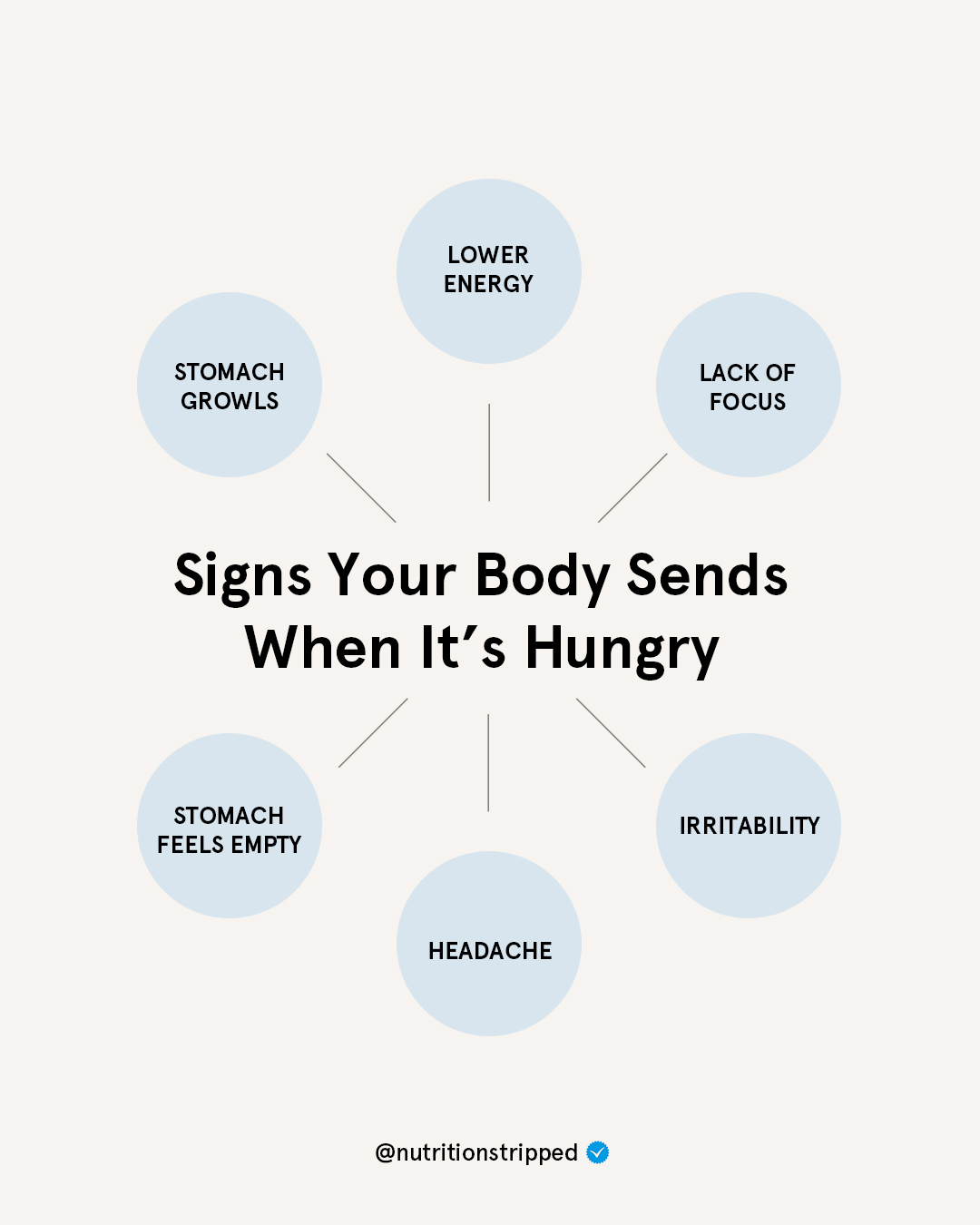Are you able to truly feel physical signs of hunger and know when to eat in response? Surprisingly enough, many people are not and they’re left asking themselves, “am I really hungry?”
But don’t worry, if you’re one of those people — we’ve got you covered.
Navigating physical signs of hunger can be a tricky game. We’re busy people with a lot going on, often times we don’t feel as though we have the time to check in with hunger or acknowledge what hunger really feels like. And even sometimes, we simply don’t know what it feels like!
We talk about mindfulness and mindful eating a lot here at Nutrition Stripped, and once again, it’s going to play a role here as well. When we’re not eating mindfully (and eating mindlessly, if you will), it’s pretty difficult to know whether or not hunger is what’s actually guiding our food choices.
To help you with that, we’re going to teach you how to be more mindful and recognize the physical signs of hunger.
But before we get there, let’s start by diving into why it’s so important that you eat in alignment with your hunger.
Why is it Important to Recognize Physical Signs of Hunger?
All day long our bodies are constantly communicating with us to let us know when we’re in need of energy, and when we’re not in need of energy. Our hunger and satiety cues are responsible for this!
The hormones that are responsible for instigating those hunger and satiety cues are ghrelin (hunger hormone) and leptin (satiety/fullness hormone).
When we feel physical signs of hunger, the body is telling us it’s in need of energy. But what unfortunately happens to many people over time, is they start to ignore those physical signs or forget what they feel like. Schedules, lack of time, stress, and diets are just a few of the many lifestyle factors that can cause this.
When we ignore or don’t notice physical signs of hunger, a chain of events starts to happen.
We can reach points of extreme hunger and lose control around food, feel lethargic, bloated, and overly full when we do eat, perpetually eat too much or not enough, the list goes on and on.
To prevent this from happening, we want to get really familiar with the physical signs of hunger.
Common Physical Signs of Hunger
When you’re checking in with your hunger and satiety cues, you’re able to acknowledge when you’re truly hungry and in need of energy.
Below are some of the most common physical signs of hunger.
Fatigue and Lack of Energy
Ever feel like you’re just out of it? Tired despite having gotten a good night of sleep? Lethargic even though you haven’t done anything particularly strenuous?
This is one of the signs of physical hunger.
We keep referring to the body being in need of energy. Well, think of energy = food. When we don’t get enough food (and therefore energy), the body can start to feel pretty crummy.
Everyday tasks are a bit harder, and we just can’t seem to snap out of it. The only way to snap out of it is to eat a nourishing meal!
The next time you’re feeling fatigued and lacking energy, be sure to check-in to see if it’s a physical sign of hunger.
Stomach Growling
This one’s easy, right?
If your stomach is growling or gurgling, and you feel that sharp pain, your body is trying to tell you that it’s in need of food.
I promise you, no matter how many diets, detoxes or cleanses out there tell you to ignore these cues for x amount of hours, it’s simply not beneficial and not true.
When we feel that pain, what’s happening, is the stomach muscle is contracting when it’s empty. The next time your stomach is growling, listen to it and respond with a nourishing Foundational Five meal!
Headache & Shaky Hands
When we’re hungry, and we’ve gone quite some time without eating, the body’s blood sugar levels can drop. Now when blood sugar is low, your body signals your brain to let it know that you’re in need of more energy, or food.
When this happens, it’s possible for the tightening of blood vessels and increased blood pressure to occur. The end result? A headache.
In addition, when blood sugar is low, it’s very common for us to feel shaky and on-edge.
If you frequently find yourself with headaches paired with shaky hands, your body may be trying to tell you that it’s in need of food. This may be one of your physical signs of hunger.
Brain Fog and Inability to Focus
These two are also related to low blood sugar. When the body isn’t receiving the energy it needs from food, the brain also isn’t receiving the energy it needs to function properly.
This can make things, well, foggy! You may feel like your thoughts process a bit slower than usual, or you just can’t focus on usual tasks as well as you normally can.
By functioning at a sub-par level, your body is trying to tell you that it needs more nutrients in order to raise blood sugar back up.
Irritability
Everyone has experienced, “hanger” before. When you’re snippy, irritable, frustrated, and sometimes downright difficult for no apparent reason. Is there anything actually bothering you? Is something wrong? Nope, it’s just hunger.
Your body is low on energy and nutrition, so once again, your blood sugar is low. When blood sugar is low, it’s much easier for us to be emotionally reactive without due cause.
If you find this happens often when you’ve gone an extended amount of time without food, one of your body’s physical signs of hunger may be “hanger” or irritability.

Signs That Can Be Mistaken for Hunger but are “Head Hunger”
But what happens if we think we’re experiencing a physical sign of hunger when in reality, it’s something else? We call this “head hunger”.
Head hunger is when a certain situation, emotion, or feeling results in the response of reaching for food.
Below are some of the most common signs of what we call, head hunger.
Sudden Cravings
Ever randomly think to yourself, “Oh my gosh, I would kill for [insert craved food item here]”, completely out of the blue?
This is a craving! Now before we dive into this one, there are certain anatomical scenarios that may cause cravings, and these indeed may have to do with physical hunger. So if you’re curious to learn more and haven’t already, head here to learn more about what your cravings may be trying to tell you.
But more often than not, it’s the taste and the food experience we’re yearning for, not physical nourishment through food. When we simply want to eat, if you will, this is a sign of head hunger.
Physical or Mental Exhaustion
Ever been so physically or mentally exhausted that all you wanted to do was eat something to feel better? Yup, head hunger.
Now I will say, this one is a little tricky. It is absolutely possible to physically be hungry as a result of exhaustion. But oftentimes, when we’re mentally or physically exhausted, and not showing physical signs of hunger, food may still sound good.
When we reach for food mindlessly as a result of an emotion or feeling, we’re not truly listening to the body’s hunger cues.
Unaddressed Stress
This is very similar to our previous example! We can do the same thing when we’re stressed as when we’re feeling exhausted.
Stress is uncomfortable and not enjoyable. Eating delicious food on the other hand is comfortable and very enjoyable. It can be very easy to develop a habit of reaching for food in stressful situations.
We call this stress eating!
When stress goes unaddressed, it festers and we look to quick, easy means to relieve it. Food is one of those means. Hunger as a result of stress is a means of head hunger rather than physical hunger.
Heightened Emotions
Lastly, we have emotions. Have you ever felt so sad, angry, depressed, or frustrated that you just needed to grab a cookie?
After the past two examples, I think it’s easy to see how this is an example of head hunger. Just like with stress, when emotions go unaddressed, we can seek relief from them through food.
Learn to Tune in to Physical Signs of Hunger
The goal here is to start to really become in tune with your individual hunger, and even satiety cues. To familiarize yourself with the physical signs of hunger you experience regularly. Once you do that, you’ll be able to eat mindfully with ease.
Inside the Mindful Nutrition Method , our students are given tools and resources to develop this skill of tuning into their body’s hunger cues so they can build confidence in knowing when to eat, what to eat, and how much to eat based on their unique needs at that moment. It’s such an empowering skill to have!
, our students are given tools and resources to develop this skill of tuning into their body’s hunger cues so they can build confidence in knowing when to eat, what to eat, and how much to eat based on their unique needs at that moment. It’s such an empowering skill to have!
Sign up to watch my free masterclass today, where you’ll learn about the #1 Habit That Keeps You Struggling With Your Weight and Relationship With Food — And How To Break Free From The Diet And Food Obsession Starting Now.
You don’t need to stress and obsess about food. There is a better way, and yes it’s possible to cultivate a positive relationship with food! Join this free balanced eating masterclass to learn how.
Watch The Free Masterclass
The post Am I Really Hungry? Physical Signs of Hunger to Look For appeared first on Nutrition Stripped®.
Erica Carneglia
Comments
Post a Comment